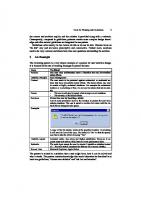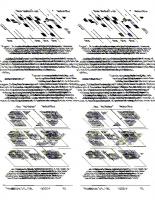Graphic User Interface for Describing Open Kinematics Chains
In this paper a graphic user interface for describing open kinematics chains is presented. The user manipulates the gene
378 26 324KB
English Pages [11]
Recommend Papers
File loading please wait...
Citation preview
17th International Conference "Systems for Automation of Engineering and Research (SAER-2003) 19-21 sept, 2003, St.Konstantin resort, Varna, Bulgaria
126
GRAPHIC USER INTERFACE FOR DESCRIBING OPEN KINEMATICS CHAINS Kaloyan Yankov Medical Faculty, Thracian University, Armejska str., 11, Stara Zagora 6000, Bulgaria e-mail: [email protected] Abstract: In this paper a graphic user interface for describing open kinematics chains is presented. The user manipulates the general 3D view of the kinematics chain and applies joint restrictions and spatial transformations to reach the goal configuration. Thus the uncomfortable Denavit-Hartenberg notation is avoided and the transformation parameters are received automatically. Key words: Biomechanics, Computer Aided Design, Robotics.
1. INTRODUCTION The Computer Aided Design (CAD) systems are helpful tools to design and study open kinematics chains (OKC). OKC are a typical part of manipulatory robots. As a constructive element they are copied from the skeletal apparatus of the vertebrate animals. There is a reverse tendency nowadays CAD systems for robotics to be used when modeling and investigating limbs of living organisms.[1,2]. The realisation of the user interface is very important because of the great complexity of the modeled object. There are a few possible approaches to create effective user interface in CAD systems for robots. • Filling in a table with input parameters. The table organization and presented values define topology, dimensional and graphical descriptions of the models [3]. • Using of high-level input language like in CAD systems STAR [4], MIRE [5], CINDY [6,7]. • Applying graph description of the КC. The system graph of the mechanical system captures the topology of the mechanism. To have a complete model, geometric information is added to the topology [8, 9]. Whatever the approach for design of computer model is the user must in advance answer some questions about: 1. Topology of the studied OKC: number, kind (revolute, prizmatic) order and mutial location of the kinematics pairs; 2. Parameter values of the kinematics pairs and joints; 3. Three-dimensional solid model of the joints; These questions require determination of Denavit and Hartenberg parameters (DHP) [10]. Their definition makes problems when describing certain types of OKC. These are OKC which are nor yet realized as a technical device and exist only in designer’s mind. For biologists and medicals investigated OKC in animale nature this engineer approach is a serious obstacle to have success when using CAD systems. The problem becomes more complicated if we must describe joints with 2 or 3 degrees of freedom. Joints of this kind are trivial for animals and human beings. A great advantage for CAD users is the availability of GUI for creation of OKC models without the necessity to be familiar with Denavit-Hartenberg notation. This way the user is not required to define the spatial location of the Cartesian coordinate system with regard to the kinematic pair and to describe their mutual position.
127 In this work is presented graphical user interface for describing open kinematics chains. The main element is a 3D image of a generalized OKC. Using interactive devices the researcher puts restrictions on the joint mobility or makes spatial transformations to obtain the goal configuration. 2. KINEMATIC MODEL A 3D OKC is defined as a finite number of bodies connected in an arbitrary fashion by joints that limit the relative motion between the pairs of bodies. For each joint i a fixed reference frame must be chosen to describe the spatial OKC motion. Denavit-Hartenberg notation is widely used in the transformation of coordinate systems of linkages as shown in the Fig1: a) axis Zi coincides with the axes of the i-th kinematics pair; b) axis Xi is a common perpendicular to the Zi-1 and Zi : Xi = Zi-1 x ZI; c) axis Yi is chosen to define right-oriented frame OiXiYiZi. The relative position of two coordinate systems attached to adjoining joints is described with the following four parameters: - θi is the angle between the links. When the joint is revolute, θi is variable and its value changes between the restrictions [θimin, θimax]; - si – the distance between the common normals of two adjacent links along the joint axis. This distance will be variable for a prizmatic joint. Its value changes between the restrictions [simin, simax]; - ai is the shortest distance connecting the two rotation axes Zi-1 and Zi; - αi - is enclosed by the axes zi-1 and zi; Independent kinematic parameters (θI or si), which define OKC position in space are called generalized joint coordinates: q = (q1, q2, .... , qN)T (1) The relative position between two adjacent links is expressed in homogeneous coordinates: АK-1,K =
cosθk sinθk 0 0
-sinθk cosαk cosθk cosαk sinαk 0
sinθk sinαk -cosθk sinαk cosαk 0
a kcosθk a k sinθk sk 1
(2)
The transformation of I-th relation toJ-th is: АJ,I = Аk-1,k(qk) k=J,J+1,…,I (3) That is the direct kinematic problem. It must be solved each time when we change the generalized coordinate values. The main difficulty in the design of a kinematic model is to establish a coordinate frame to each kinematic pair and to measure the four DHP. 3. INTERACTIVE DESIGN SCENARIO FOR GENERATION OF OKC The goal of the graphical user interface is to reflect the structure of the models and to display the data used or produced by the corresponding software. This structure contains model components (joints, links and attached coordinate systems) and relations between the components (DenavitHartenberg parameters). The components of the model might have corresponding geometric shapes. Graphical user interfaces for such models should include display of the shape. The relations and attributes are usually visualized in a graphical user interface as links between the shapes or visual properties of the shapes. The design scenario follows the indicated stages.
128 1. Generelized OKC-model generation (фиг.2). This model aids the user to appreciate the spatial position of chain components. Applying consecutive restrictions in joints the goal configuration is reached according to designer requirements. The number of generalized coordinates is unimportaint because in the process of creation of OKC it can increase or decrease. Partcular 3D solid models can be chosen later. 2. Editing of the OKC topology: adding or deleting joints. When adding new joint its coordinate frame coincides with the previous one. All DHP have zero values and the transformation matrix АK-1,K is identity matrix. 3. Change of DHP values (а, α, s or θ) of a specified joint. This action leads to reestimation of the transformation matrix and alteration of the OKC configuration. The direct kinematic problem is solved (Eq.3) and a new interactive model is displayed. This permits to see how much the DHP changes alters OKC configuration 4. Supervisor control of joint coordinates and motion observation. If the joint is revolute, the controlled parameter is θ and if it is prizmatic it is s. In this case the motion abilities of OKC are checked. 5. 3D-transformations: translation and rotation in the absolute or the joint coordinate system. The spatial transformation is converted to the corresponding change of DHP values. Using these interactive abilities the user is able to synthesize an OKC even if he is not familiar with the nature of DH notation. The character of the mathematical description remains hidden behind the graphics image of the model. 6. Saving the model in a file. This is a trivial operation. 7. Generation of the program with the OKC description [6].
4. EXAMPLE Spherical joint have three revolute degrees of freedom (fig.3). In engineering it is used rarely because of technological difficulties. In the in animate nature it is encountered frequently. In the humans such are the soulder and the thigh joint.
129 In the spherical joint the revolute movements intersect in a certain point and the links have zero length as in the shoulder joint or they are very short as in robots. Thit fact makes it difficult to establish a local coordinate system and DHP. According to the model on fig.2 the third rotation is unnecessary and the fourth must be on 90 degree around axis Z, in order for the fourth axis to become parallel to axis OY of the absolute coordinate frame. Following rotations are unnecessary too. Thus is generated a structure RRR with mutually perpendicular axes of rotation (fig.4). The corresponding DHP are in Parameters Table in Figure 5. The figure shows clearly that parameters s2 s3 must be 0, in order to obtain a spherical joint. Joint s a α [DEG] θ 1 0 0 90 2 0 0 90 3 0 0 0 The description of the joints generated with the application-oriented language [6] is: RQ1, RAD(90); RQ2, RAD(90); RQ3, RAD(0).
Fig.5
130 5. CONCLUSIONS One of the greatest advantages of the interactive computer graphics is the ability to present dynamic 3D images which can be inspected by any angle and modified according to the desired goal strategy. 3D view and animation increases the community and the intelligibility of the GUI. DH notation is essential stage but very specific and difficult for the users without broad engineering knowledge. Thus GUI helps to avoid the direct application of DHP from the user without affecting the quality of the description. The GUI helps to optimize the entry times and reduce the mis-types. It combines simplicity of expression means with great descriptive and modification ability. The great opportunities come together with minimal efforts from the user. REFERENCES 1. Skotte J.H., M. Essendrop, et al, A dynamic 3D biomechanical evaluation of the load on the low back during different patient-handling tasks, Journal of Biomechanics 35 (2002) 1357–1366 2. Degueurce C., H. Chateau, et al, Concrete Use of the Joint Coordinate System for the Quantification of Articular Rotations in the Digital Joints of the Horse, Vet. Res. 31 (2000) 297– 311 297 3. Derby St., GRASP – From Computer Aided Robot Design to Off-line Programming, Robotics Age, febr. 1984, pp.11-13. 4. Hornic, M., Computer Aided Off-line Planning and Programming of Robot Motion, Int.J. of Robotics Research, vol.4, 1986, pp.18-31. 5. Liegeois A., A.Fournier, M.Aldon, P. Borrel, A System for Compuret Aided Design of Robots and Manipulators, Proc. 10th ISIR, march 5-7,, 1980, Milan, Italy, pp 441-452 6. Yankov K., Application-Oriented Language for Describing Open Kinematic Chains, 16th International Conference "Systems for Automation of Engineering and Research (SAER-2002, 20-22 sept, 2002, St.Konstantin resort, Varna, Bulgaria, pp.95-99. 7. Uzunova V., K. Yankov Analytical Model of Human Body Joints, Jubilee Scientific Conference, oct. 18-20, 2002, Stara Zagora, Bulgaria, pp.21-25. 8. Diaz-Calderon A., C. J. J. Paredis, P. K. Khosla, On the Synthesis of the System Graph for 3D Mechanics, 1999 American Control Conference, San Diego California, June 1999. 9. Diaz-Calderon A., C. J. J. Paredis, P. K. Khosla, Automatic generation of system-level dynamic equations for mechatronic systems, Tech. Report, Institute for Complex Engineered Systems, Carnegie Mellon University, Pittsburgh PA, 1999. 10. Denavit, J., Hartenberg, R. S., "A Kinematic Notation for Lower-Pair Mechanisms Based on Matrices," ASME Journal of Applied Mechanisms, 1955, pp. 215-221.










